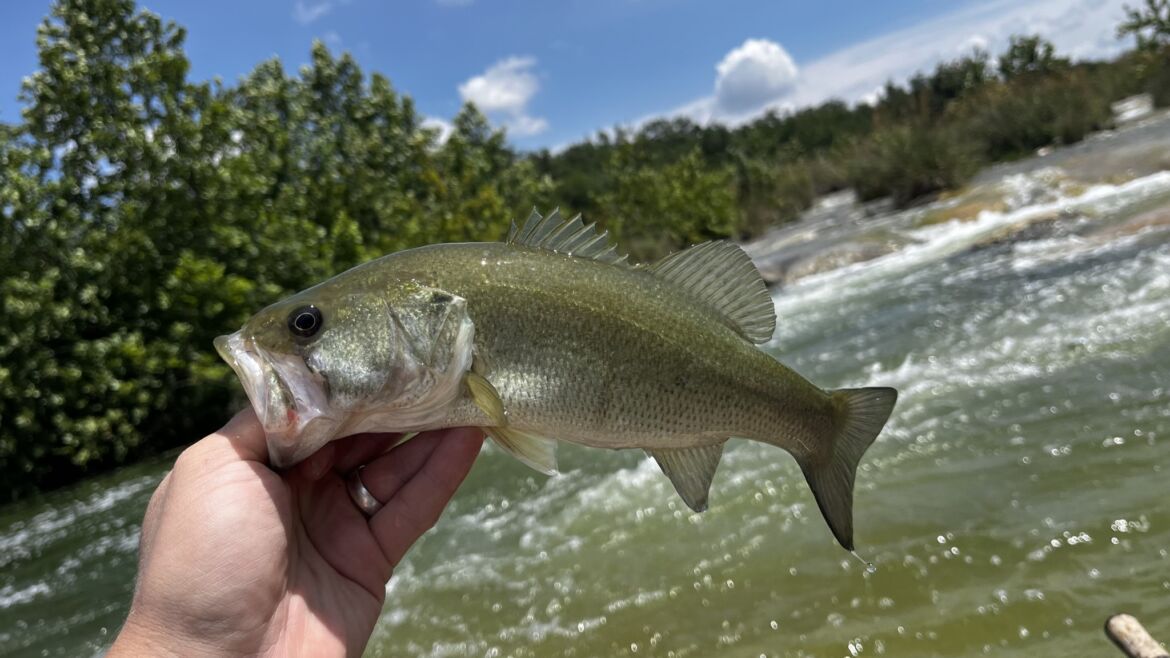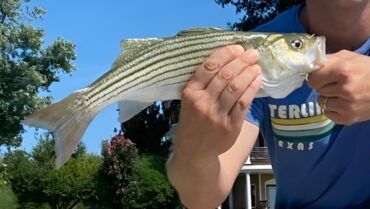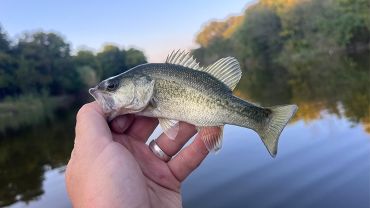There’s a reason that Largemouth Bass is one of the most popular fish species in the United States. Their large size, healthy appetite, and ferocious fight, especially on light tackle, make them one of the best freshwater species in North America. It’s no surprise that anglers across the country enjoy chasing these beautiful fish.
In the warmer states like Florida and Texas, Largemouth Bass grow especially big, making for an excellent fight. During their first year of life, Bass grow 4-8 inches, then 14 inches in their second year, and up to 18 inches in the third year.
Get your personalized fishing map
Answer a quick quiz and get your own personalized fishing map
You’ll be able to recognize Largemouth Bass by their distinctive light to dark green coloring and darker blotches form in horizontal lines down both sides of the fish. They have a divided dorsal fin, with the anterior fin containing nine spines and the posterior fin containing approximately twelve rays.
Two of the top destinations for any angler considering a Largemouth Bass destination fishing trip are Texas and Florida. In the following guide to the best baits and lures for Largemouth Bass, we’ll cover:
If Bass fishing is your passion, or you’re just starting to fall in love with these excellent fish, check out Master Bass Fishing: A Comprehensive How-To Guide for Bass Fishing to learn more about catching Bass in your local area.
Experts’ Opinion on The Best Bait and Lures for Largemouth Bass Fishing
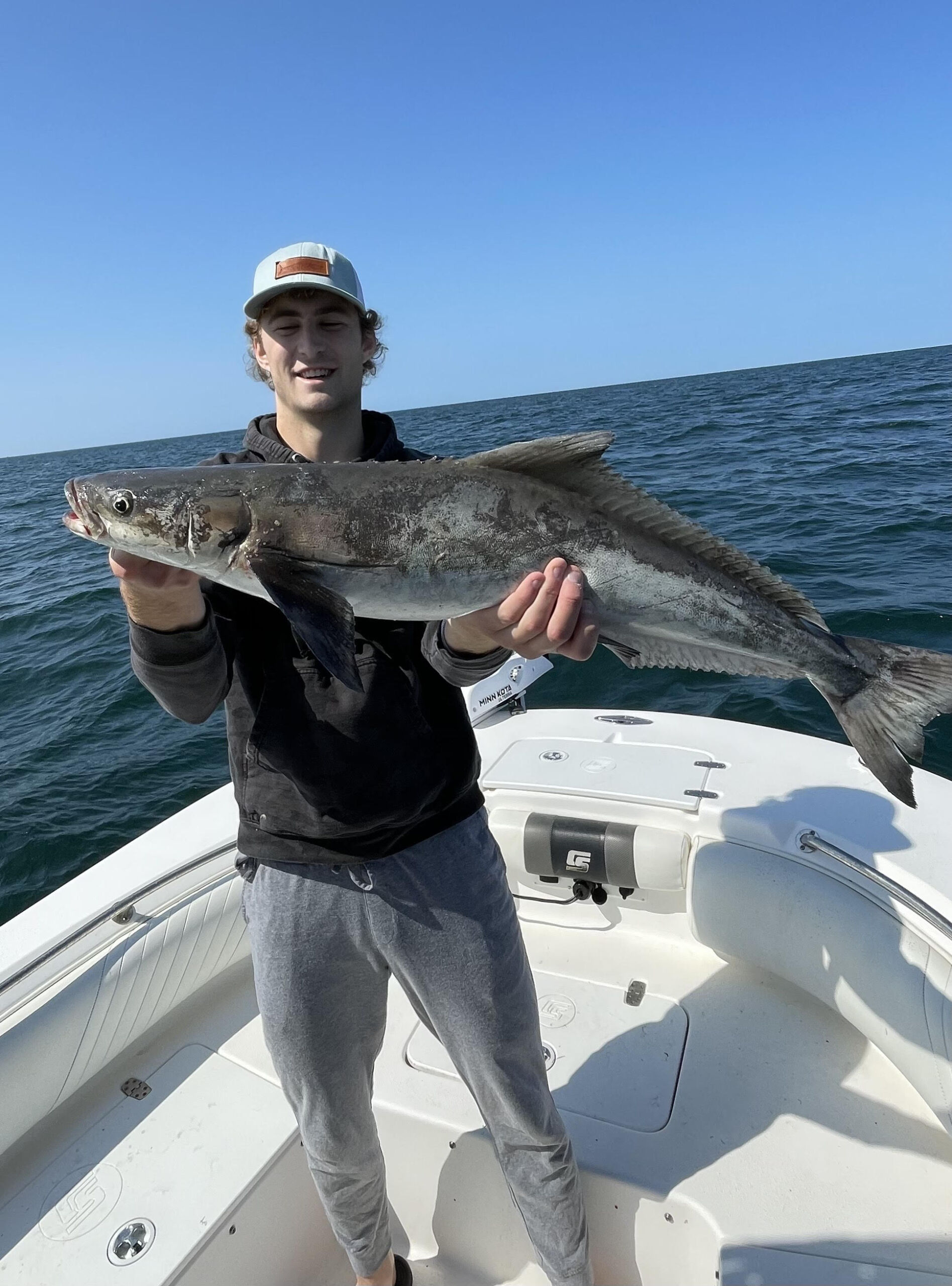
Pierce Latta
16 years fishing experience
“Nowadays, there are simply too many baits out there for largemouth bass making it hard for anglers, especially newer and less experienced bass anglers, to pick baits that will give them a good chance of success. Luckily, this article gives us a ton of helpful information regarding this very topic which will allow us to hopefully narrow down our potential options giving us the best chance of catching that trophy largemouth bass.
The article first begins with a description of the largemouth bass and its extremely quick growth in only a few years’ time. We then move into a section talking about understanding the behavior of a largemouth bass. The article gives some super helpful information regarding the food that bass eat, even giving us details as to how this diet may change in different bodies of water as well as with the growth of the fish. We also get a bit of discussion on the predatory nature of bass and how they like to ambush their prey. This also plays a factor in what bait to fish because you want to generally fish with something that they feel comfortable with or even compelled to attack.
Soon thereafter, the article briefly touches on the different stages of spawning and how this will affect what the bass wants to eat or not eat.
We then move into the meat of the article opening with a discussion on using live bait for bass. We are presented with a few different options for what we could use and before we go any further, I would like to discuss something. I do feel like live bait fishing for bass gets a lot of hate for really no reason. “It’s cheating” or “it makes fishing too easy” are things I’ve heard for a while now.
Reality is, live bait, when fished correctly, can outperform almost any artificial—and not just for bass, but for a ton of other species as well. Also, people can fish how they want to fish—that’s the beauty of fishing. Everyone has different tactics and strategies that appeal to them so please don’t criticize someone else’s tactics just because you don’t prefer them. Anyways, we continue talking about bait doing a deep dive into some of the proven live bait. This was super helpful to me as it opened my eyes to some baits that I need to try in order to expand my fishing game.
Lastly, we move into everyone’s favorite part—artificial baits. There is just something so much more fun in my opinion when using artificial baits. There’s something about tricking a bass into thinking a plastic lure is real enough to bite. There’s a feeling of reward knowing that you tricked a bass into biting something not real. I love this aspect of it. The article goes into more detail about some specific lures, all of which I love using and would encourage y’all to use as well.
Just before the conclusion, we get one last section on the best practices when fishing for largemouth bass touching on things like water temperature and other things. Take these into careful consideration when fishing using things like the Fishbox app to help you out. One thing before you leave: fishing is a science, but you can only hypothesize so much. You must be willing to get outside and try new things in order to see what works. Never be afraid of trying something new on the line—that’s the fun of it. I hope you guys have enjoyed reading this article and my comments and as always, good luck and tight lines!”
Visit his Instagram profile.
Subscribe to his YouTube channel.
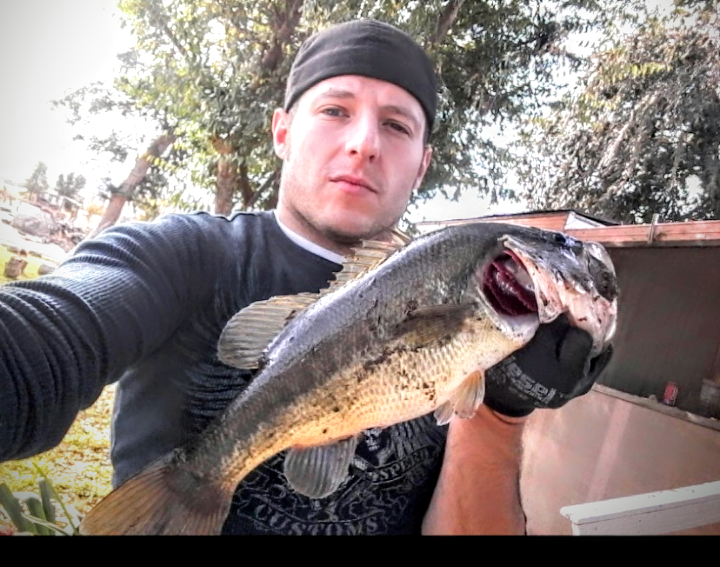
Andrew Timmerman
“With an abundance of lures and baits that are great for bass, I will simplify a few of my personal go-to lures. I reside in California, where live bait isn’t allowed in most places, unfortunately, but luckily, there are lures like Strike King Tour Grade Football Jig, Lunker worms, and basically all purple-green colored Roboworms that are very versatile and effective whether the bass are spawning and in varied conditions and settings.
For example, through weed beds while on a boat, a football jig finessing is irresistible to Bass, BIG BASS. From shore, I’ll use a football jig as well as from shore if the water is deep enough along with a big enough bobber slip style, and I’ll finesse it along, and you can’t lose.
If you’re not getting bites or in the right setting for a finesse jig, the Roboworm is always a reliable choice. I’ll swim them along the shore early in the morning, and when the action slows down, I’ll add a sinker and send it down a few more feet. These are what I call fishing happy hours: the few hours after sunup and the hour before sunset.
When that doesn’t get as much action as I like, I’ll lose the bobber and drop that bad boy all the way down, stirring up the bottom to entice them to fish a bit more.
Hopefully, this helps. Happy fishing, you all!”
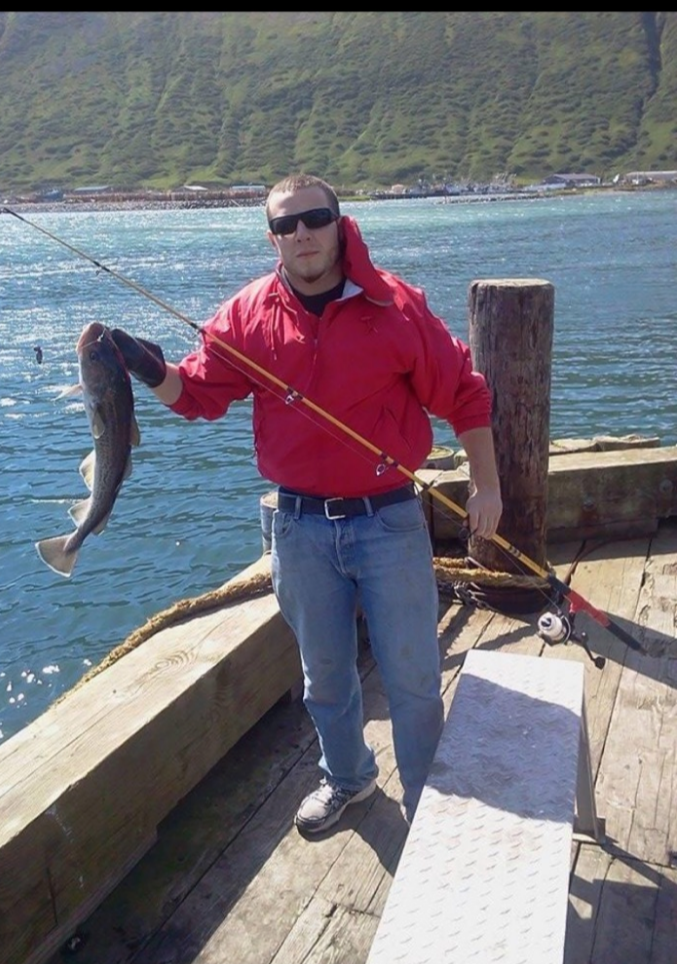
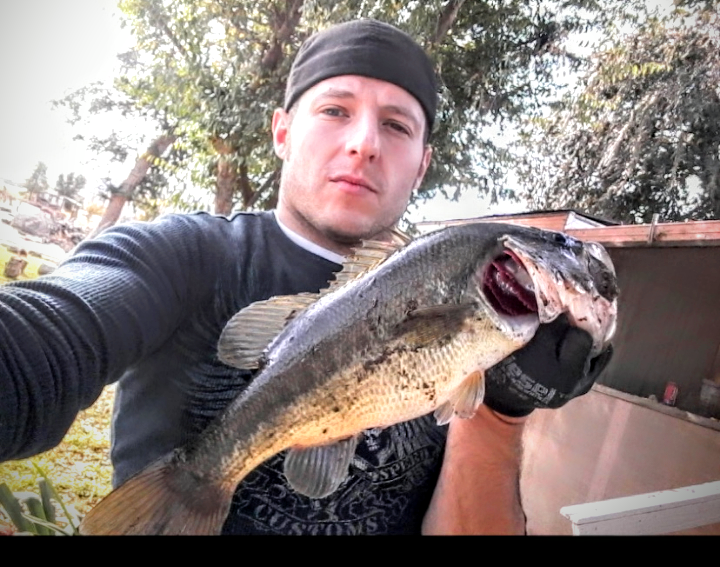
Understanding Largemouth Bass Behavior
One thing that you need to consider if you’re planning on taking your Largemouth Bass fishing to the next level is that no two Bass fishing locations are going to be the same. Whether you’re fishing in Canada or the United States, you’ll need to carefully consider local conditions if you want to maximize your catch rate.
Juvenile Largemouth Bass will mostly eat small insects, baitfish, shrimp, and scuds. As they grow, their diet will shift to larger prey. Larger prey includes things like Crawfish, Bluegill, Shad, Snakes, Frogs, Perch, small birds, lizards, and even baby alligators. As they grow, they turn into voracious predators, and there isn’t much within their environment that’s safe.
In the larger reservoirs and lakes, they will focus more of their attention on smaller baitfish, consuming Trout, Sunfish, Walleye, Catfish, Striped Bass, Yellow Perch, Shad, and much more. No small fish are safe when a hungry Largemouth Bass is lurking around.
Depending on the size of the Bass population, they will quickly work their way through schools of baitfish. Any lakes, reservoirs, or bodies of water with a high density of weed beds and vegetation will provide Bass with a more balanced and healthier ecosystem, allowing them to grow and thrive.
Largemouth Bass are considered to be an ambush hunter. They like to hang out in sheltered areas, around or underneath structures such as banks, drop-offs, rocks, docks, and weed beds. Any banks that have large trees overhanging them will be an attractive area for these predatory fish to lurk around in. They utilize hearing, sight, smell, and vibrations in the water to locate their food.
You’ll find Largemouth Bass in lakes, reservoirs, ponds, streams, and rivers across the United States and Canada. While they themselves fall victim to larger fish when they’re young, once they mature, they quickly turn into voracious predators.
Spawning
These fish are capable of consuming large amounts of food, particularly during the pre-spawn and post-spawn periods. The spawning behavior of Bass is broken down into three distinct periods:
- Pre-Spawn.
- Spawn.
- Post-Spawn.
The start of the Bass spawn will ultimately depend on the weather and water temperatures, and this varies depending on the location. In warmer states like Florida and Texas, the spawning period will start a lot earlier than in northern states where the weather is a little cooler.
You want to get ready to hit the water once water temperatures start to hit 55-65 degrees Fortnight and remain consistently in the 60-degree range. Look for the first full moon within this temperature range, and you should be right on the money to take advantage of the intense spawn action.
During the spawn, male fish locate and create the ideal bedding locations ready for the female fish to come in and lay their eggs. Once the eggs have been laid by the females, the males fertilize the eggs, and the females leave the bedding area, leaving it up to the male fish to guard the eggs and young fish as they hatch.
Once you know what to look for, it can be significantly easier to locate bedding areas. Search for large or small circles that have a white center. These can be indicative of Bass spawning beds. If you’re planning on fishing for Bass during the spawn, it’s vital to remember fish conservation. When you catch male fish on the beds, return them so that they can continue their job of protecting their young fish so that we all have more fish to catch in the future. Try to return fish as safely and quickly as possible to the water in order to give them the best chance of survival.
Read also: When Do Bass Spawn: A Comprehensive Guide to Bass Spawning Season
Live Bait for Largemouth Bass
Live bait is an effective way to target Largemouth Bass and doesn’t require as much presentation as artificial lures, but it will require some work both sourcing live bait and keeping them alive while you’re out on the water.
In this section we’ll be covering some of the best live baits and how to present them in order to give yourself the best chance of success.
Two of the most common food sources for Largemouth Bass are small baitfish and crawfish. Other popular live baits include worms and frogs, bugs, larvae, and even mice. It all depends on where you’re fishing and what the fish are most likely to eat in that location. For this reason, it pays to do a little digging around in the area you plan on fishing to see what the most common food source is. If you can’t do a little scouting, try talking to local anglers and see what baits they find most successful in their area.
If you want your live bait to be successful, it needs to appear and act as naturally as possible. Remember, do your homework! It’s no use fishing using frogs if the Bass in the area you’re fishing in have never seen a frog before.
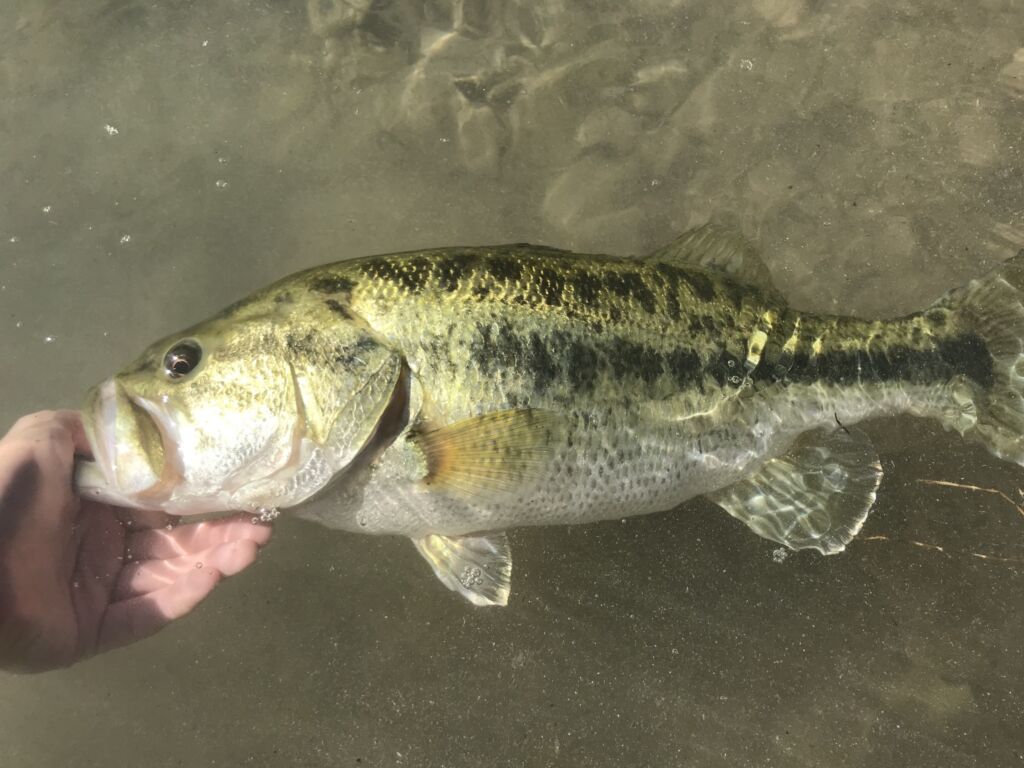
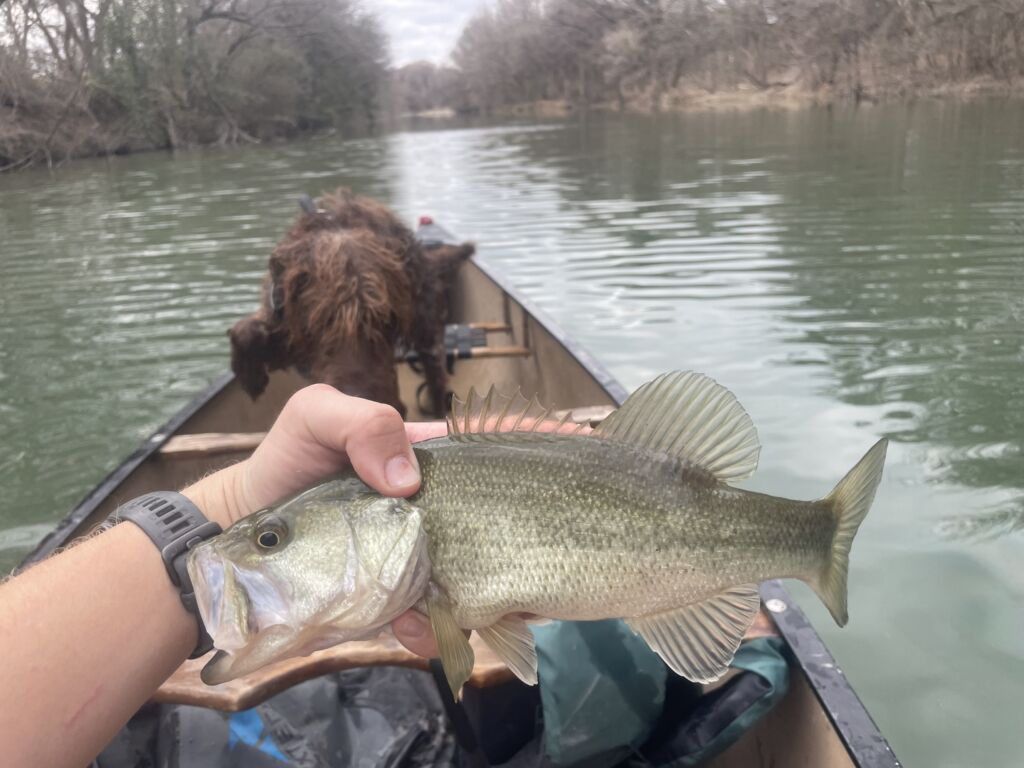
Ultimate Largemouth Bass Baits and Presentation
These are the most consistent go-to baits for Largemouth Bass anglers, and many professional Bass anglers are the top choices for go-to live baits. Be sure to keep an eye on your bait and check it frequently to ensure it hasn’t died. Much of the appeal of live baits is, you guessed it, they’re alive. If they die in the water, reel them back in and switch them out for fresh bait.
Baitfish – Minnows, Herring, and Shiners
How you rig your baitfish will depend a lot on how you want it to look and act once you cast it out into the water. The most common method is to hook the bait through its lips from the bottom up. It leaves the baitfish with the ability to swim naturally and also has the added benefit of not damaging it. You can also go through the back, just below its dorsal fin. However, you’ll need to keep a close eye on how healthy it is.
While live baitfish are great in all waters and depths, deep water is where they really shine. Don’t be surprised if you encounter a lot of by-catches when using live bait, as they’re attractive to a lot of other species, such as Trout, Walleye, and Catfish.
Fishing live baits under floats or bobbers is an effective way to catch big fish. When the float or bobber goes beneath the water’s surface, you know it’s time to strike and set the hook. The float will also help to keep the bait off the bottom.
Another method for using live bait is to add a split shot sinker to the line. This is effective in shallow water, where you want to stop the live bait from swimming to the top of the water, keeping it in the target area.
Crawfish
Crawfish, otherwise known as crawdads or crayfish, are extremely popular as live baits for most freshwater species, including Largemouth Bass. However, you’ll need to perfect your presentation when using them.
When you’re using crawfish, don’t just use the same size hook for every bait unless they’re a consistent size. You want to hook them through the tail using a hook that is in proportion to their size. Cast them out close to vegetation and rocks, or you can try allowing them to drift with the current.
Worms
Nightcrawlers and worms are very effective Bass baits. If you’re fishing with inexperienced anglers or kids, worms are a lot of fun. Match the size of the worm to the hook you’re using. You don’t want a giant hook 2-3 times the size of the bait. Put the worm on the tip of the hook, covering as much of the hook as possible. Be sure to keep the barb of the hook exposed so that you can set the hook when you get a strike.
Worms work well in shallow areas using light tackle. Using light lines and tackle makes it a lot easier to feel bites and set the hook. You can also float worms or jig them.
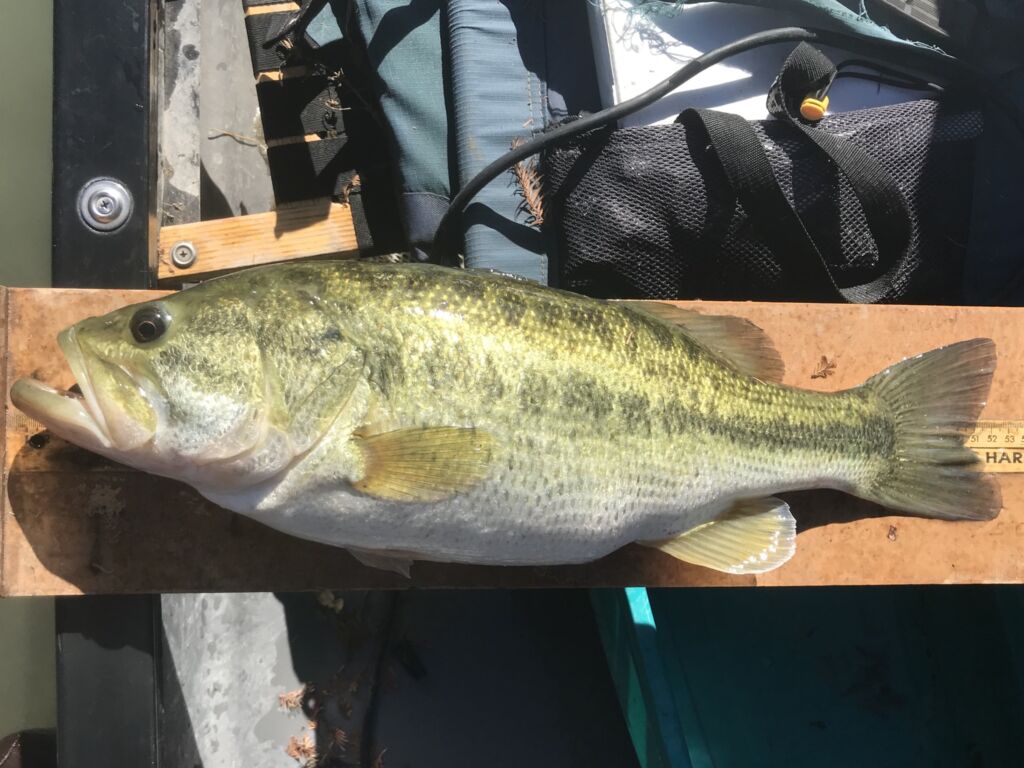
Frogs
Frogs often don’t get the credit they deserve as Bass bait. Anywhere with heavy vegetation or a lot of cover is a great place to use frogs as bait. However, frogs aren’t as beginner-friendly as worms or baitfish.
When you rig your frog, you want to use a wide gap hook with an added split shot about a foot above the hook. Thread the hook through the forelegs of the frog. This will present it as naturally as possible while still allowing it to swim naturally.
Cast your frog close to the structure or cover, and the frog will typically swim straight to the bottom, drawing the attention of any bass in the area. By using a jerking motion with your rod, you can make the frog appear more erratic, getting the attention of nearby fish.
Get your personalized fishing map
Answer a quick quiz and get your own personalized fishing map
Artificial Lures for Largemouth Bass
It’s tough to write about the best artificial lures for Largemouth Bass as there are so many and so many different factors that influence how effective they’ll be in certain situations, but we’ll do our best!
Because of their aggressive feeding habits, Largemouth Bass are susceptible to most artificial baits and lures, so narrowing down the top ones can be difficult. In this next section, we’ll look at jigs, frogs, soft plastics, crankbaits, and spinnerbaits.
Ultimately, the artificial lure you choose will depend on when and where you’re fishing for Bass. Unlike baits, most lures require a certain amount of skill, which makes them not the first choice for beginners or kids. If you’ve had any experience with artificial lures or jigs, most of the baits we talk about in this next section should be within reach.
Jigs
There are various jigs, including swim jigs, football jigs, and pitching jigs. Regardless of which jig you choose, most are irresistible to Largemouth Bass and their aggressive feeding style.
Frogs
Not to be confused with live frogs, frog lures such as the hollow-belly frog are extremely fun ways to catch Bass. Unlike other artificial lures, frogs can be fished effectively in almost any body of water, which makes them an extremely versatile lure. You can choose from a variety of different colors, and both popping and standard versions.
Soft Plastics
There are a variety of lures, all within the soft plastic category, including stick baits, ribbon tails, worms, and creatures that Largemouth Bass all love to gobble up. Soft plastics are extremely versatile and can be used in almost any body of water. Add to that the fact that they’re reasonably priced and quick to replace, soft plastics are a go-to choice for a lot of Bass anglers across the country. Try to mimic what the Bass are feeding on in your fishing area when choosing the type and color.
Crankbaits
From deep divers to shallow square bills, a crankbait is a great choice, and with different types and styles, they give you a lot of versatility. You want to match the color of the lure to the water clarity you’re fishing in, so be sure to choose the appropriate lure for the depth of water. Hitting the bottom with your crankbait. It’s an excellent way to stir up the bottom and get the attention of any fish lurking nearby.
Spinnerbaits
Finally, the last in our range of best artificial lures for Largemouth Bass are spinnerbaits. Spinnerbaits have been used by Bass anglers for generations and still continue to catch trophy-sized fish consistently. There are various colors to choose from, but the tried and true classic colors include white, solid white, chartreuse, or anything that looks like a Bluegill.
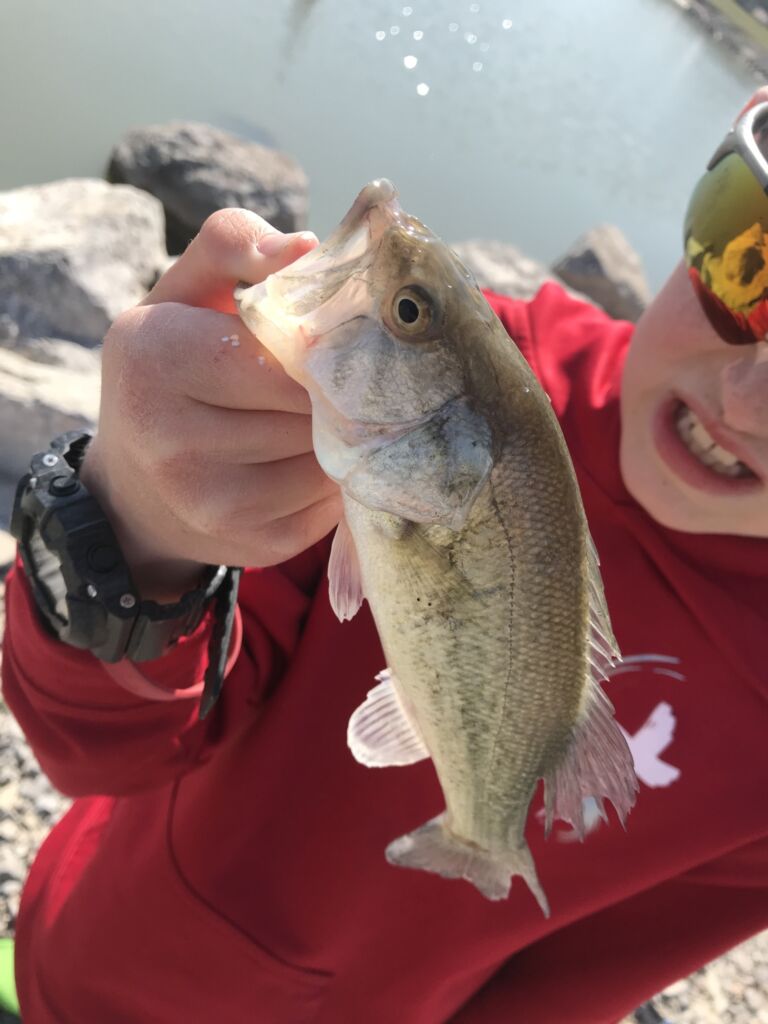
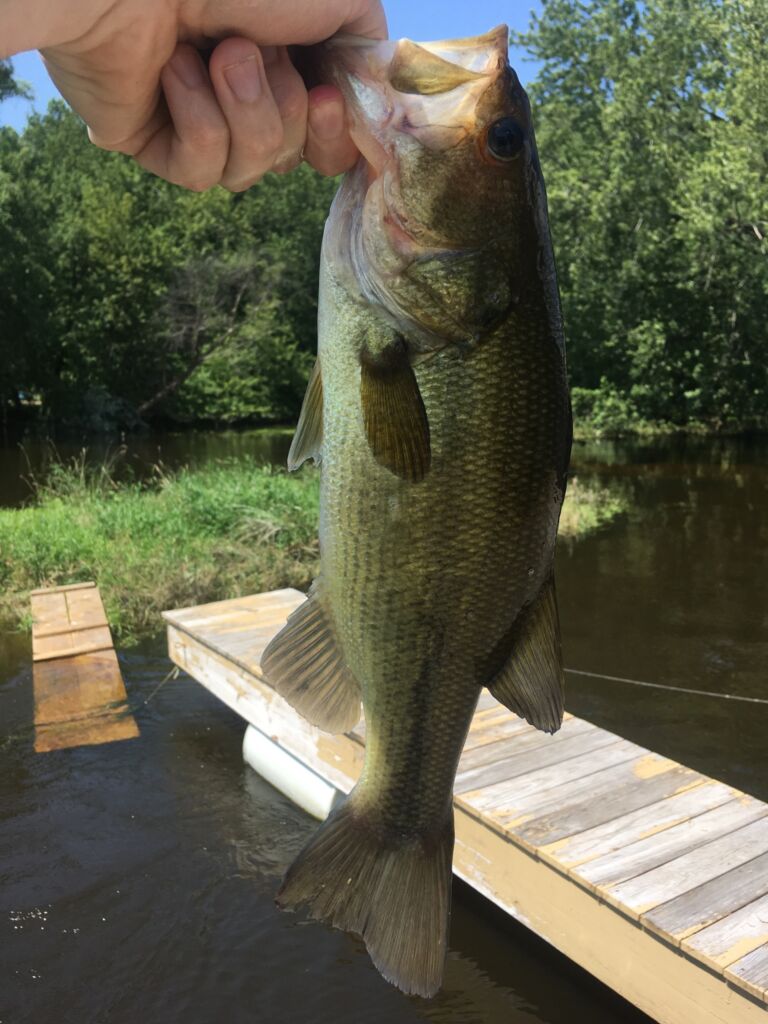
Best Practices for Largemouth Bass Fishing
One of the best things about catching Bass is that you can fish for them year-round in various conditions and seasons. While spawning season, before, after, and during the spawn, can be the most productive, you can still find some great Bass action year-round.
By studying Largemouth Bass, like any fish species you plan on targeting, you’ll have a much better idea of their lifecycle, habitat, and how they feed. For example, during their spawn, they’ll be found closer to shore, likewise during summer mornings or winter afternoons when it’s a little warmer in the shallow water.
The rest of the time, it’s common to find them in deeper water, especially when you’re chasing large fish or trophy-sized Bass. In this section, we’ll look at some of the factors which influence Largemouth Bass behavior.
Water Temperature
The temperature of the water plays a significant role in where fish are and how they feed. When the water temps are low, fish tend to be a lot slower and lazier. They’re not racing around chasing bait or food, so you’ll need to adjust your retrieve speeds accordingly. When the water starts to heat up, the fish become more active and are much more aggressive in how they hit lures or jigs. Once the water reaches its peak temperature in summer, it’ll move to deeper water and slow down, meaning you’ll need to target it in the morning or evening.
Bass Tips for Any Conditions
Largemouth Bass like hunting for their food in areas that offer a lot of cover so that they leave cover and ambush their food. Try casting into cover or near cover and then retrieve from there.
It can take a little bit of practice to learn how to cast into cover, so it’s worth setting up a practice bucket or container in your backyard and practicing your casting if you want to avoid losing a lot of gear in the beginning.
Fishing for Bass can take a lot of patience, but like many other anglers, once you master it, you’ll be hooked for life. Pay close attention to the environment you plan on fishing in. Look at the food the Bass are most likely feeding on, and then use that information to mimic them with your lures or jigs.
The Best Bait and Lures for Largemouth Bass Fishing – Conclusion
Now, you should have a much better understanding of how to effectively catch Largemouth Bass, including their behavior, the effectiveness of live baits, artificial lures, and much more. There’s just something magical about these fantastic fish.
As responsible anglers, it’s up to us to do everything possible to ensure the longevity of the fishery and be stewards of the species. By following season, size, and bag limits, along with only taking the fish we need, we’ll be able to ensure that future generations of anglers can enjoy the same fantastic fishing we get to enjoy for many years to come.
Within the Fishbox, advanced technology will allow anglers to effectively track weather conditions accurately and enable them to predict the best times to go Largemouth Bass fishing. Fishbox App combines weather, lunar, and tidal conditions with predictive fish behavior to deliver optimal Bass fishing opportunities throughout the United States.
Get your personalized fishing map
Answer a quick quiz and get your own personalized fishing map
If you’d like to share your Largemouth Bass fishing tips and tricks with other anglers, comment below. We love reading your feedback, and any tips, tricks, or advice will assist new anglers who are just getting into the Bass fishing scene for themselves.
